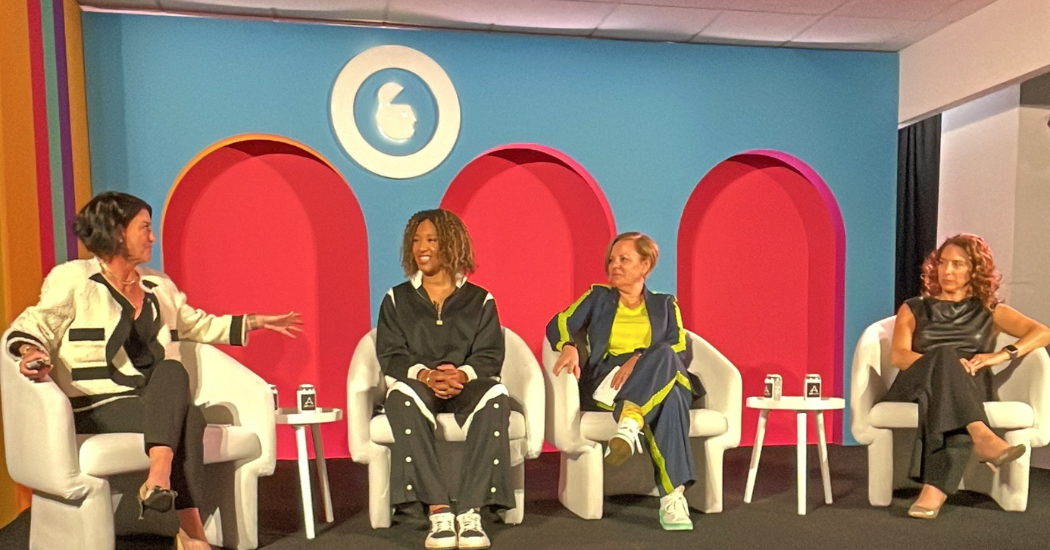Recapping Advertising Week New York: Key Themes and Takeaways

Rain the Growth Agency had a number of CREW attend AWNY, October 16-19, to capture the latest insights on creative and media trends in the advertising world. We recap the key themes from some of the informative sessions below.
Tapping Into Women’s Sports to Drive Performance Marketing Goals
By Sue Collins, Chief Client Officer
With an Equality lounge powered by the Female Quotient and another year with a dedicated Future is Female track, it was evident the power of women would be a highlight again at this year’s event.
In particular, womens’ sports and their growing audience base was a frequently discussed topic. Our very own co-founder and chairwoman, Michelle Cardinal, discussed how to tap into womens’ sports media and content opportunities to meet performance marketing goals alongside Darren Brown, Head of Marketing at OOFOS; Sara Gotfredson, Founder and CEO of Trailblazing Sports Group; Deidra Maddock, Vice President of Sports Brand Solutions for The Walt Disney Company; and Aerial Powers, WNBA Forward for the WNBA’s Minnesota Lynx, streamer and brand ambassador.
The panel discussion highlighted recent in-person and viewership events such as the U.S. Open Finals, University of Nebraska volleyball game and the WNBA Finals, as well as characteristics of fans of female sports (FOFS) and how they engage with content.
Key takeaways from the panel include:
- FOFS skew younger (but are across all generational groups), educated and affluent
- The growth in women’s sports is not a moment— it’s a movement
- FOFS have higher engagement and loyalty— female athletes have twice as much social media engagement than male athletes
- 54% of fans are more likely to purchase from brands female athletes promote
- For brands looking to invest in women’s sports, a cross-channel approach can help meet consumers where they are as fans consume contents across multiple screens
- Brands partnering with athletes should have a compelling and authentic story to tell— integrating athletes’ input is key in the creative process
- Partnering with a seasoned performance marketing agency can help brands navigate a highly fragmented media landscape
- It’s possible to test into women’s sports media or content. A detailed test and learn plan can help prove viability and plan for scale
For more information about how Rain the Growth Agency is connecting brands to women’s sports audiences, visit our HypeHer page.

The Challenge of Capturing Consumer Attention
By Susan Boland, Vice President, Communications Strategy
Today’s consumers are inundated with more content and advertising messages across more platforms than ever before. Louise Dilulio of Advertising Week, and Mihael Mikek of Celtra, discussed how with so many options and distractions competing for their attention, it can be incredibly difficult for brands to effectively reach their target audiences.
A major challenge is the consumer attention deficit. Even if a brand gains a consumer’s focus, retaining engagement is an uphill battle. This makes it critical for marketers to create content that immediately grabs attention.
Fragmented channels and formats add further complexity. Consumers engage across social media, streaming TV, podcasts, messaging apps, and countless other digital platforms. Creative campaigns need to be tailored and optimized for very different environments with distinct audiences (age, ethnicities, geographies). Brand messaging that resonates with urban millennials may completely miss the mark for rural baby boomers.
Personalization is Key But Can Be Costly
While creating personalized content increases engagement, manually creating personalized content requires substantial resources.
Most marketing budgets and production capacity have remained steady even as content demand has dramatically increased. This widening gap makes effective personalization difficult. Most marketing teams cannot scale creative production with their existing resources and budgets.
Personalization at Scale Calls for Automated Solutions
While technology has optimized media delivery and performance, creative content represents an area where there is still ample room for improvement and remains a largely manual process. There is a major opportunity to leverage automation at scale to deliver personalized content creation and bridge the gap between rising demand and limited resources. The solution is a collaborative automation platform that can help scale creative production to keep pace with rising content demands.
By building modular design templates, much of the production process can be automated by pulling in dynamic data feeds. Humans still drive the strategy, creative direction, and oversight. Automation takes care of the heavy lifting of assembling and localizing thousands of assets. This is the next frontier of marketing technology—scalable, automated creative production.
With modular design, marketers can easily test and iterate different creative elements. By using the same templates and swapping out pieces of content or visual assets, marketers can run A/B and multivariate tests to see what resonates best with your audience.
The Role of AI
AI holds great promise for improving creative content production at scale. AI tools can generate copy, images, video, and other assets to help expand the volume of content produced. However, AI on its own is not yet capable of fully replacing human creativity and strategic thinking.
AI systems excel at crunching data, identifying patterns, and producing content based on templates and examples. But the human touch is still essential for high-level messaging, emotion, and making judgments about what content will truly resonate with target audiences. Humans must continue driving AI technology for the foreseeable future.
The Future of Automated Creative
Automated creative production holds great promise for the future of marketing content. As AI technologies and content delivery platforms continue to advance, automated systems will likely become capable of generating highly personalized, optimized creative assets at scale. This could enable a future where customized content is seamlessly tailored to each individual consumer.
The long-term vision is automated creative that provides true 1:1 personalization, generating the right content in the right format for the right person at the right time. This could drive tremendous gains in marketing performance, delivering customized experiences that feel like they were designed just for you. With the power of data-driven automation, the future of creative production is true customization and optimization at scale.

CTV Fragmentation Transparency and Measurement
By Ryan Gilbert, Vice President, Digital Media
We all know that CTV is one of the fastest growing channels in the marketing landscape. U.S. consumers continue to view more content in the channel with every passing month. This trend is not only continuing to create fantastic investment opportunities within the channel, it’s also beginning to position CTV as a must-have on most brand’s media schedules.
While CTV investment opportunities for both brand and performance campaigns are becoming more exciting, we’re still faced with some very real challenges in this space. Programming transparency and measurement are key areas that brands and buyers should be pushing publishers and adtech partners across our industry.
Programming Transparency
Purchasing CTV inventory with show-level data continues to be a very real challenge. Today, roughly 85% of all CTV inventory is being made available to buyers with no transparency into its show-level data. For reference, CTV publishers and exchanges were only passing genre-level data 10% of the time just a year ago. Today that figure exceeds 80%; making it clear that if buyers demand more transparency in their inventory then progress can be made. Buyers have to continue to demand show-level data from the ad community in order to make the same meaningful progress that we saw with genre-level data over the past year.
Many publishers continue to push for brands to secure addressable private marketplace (PMP) audiences when accessing their inventory. While there will be a continued need for addressable targeting in CTV, it should not be the only approach considered. For a variety of reasons, brands should be closely evaluating a broad-audience targeting approach in addition to addressable. That said, the ability to access show level data would prove advantageous to brands that are considering buy-type strategies, targeting solutions and performance outcomes.
Measurement Challenges
The measurement solutions that worked for brands with linear video schedules in the past few decades will not work for brands as CTV emerges as a primary media consumption channel for video. CTV cannot be measured with panels since it’s typically not viewed in real time. According to the Joint Industry Committee (JIC), “the legacy incumbent is no longer our long-term solution across the industry.” And while the natural assumption to make is that everything in digital is more measurable, CTV is presenting some real challenges for agencies and brands. For starters, log file activity, ad IDs and syndication details are not being made uniformly available across our industry. Instead, individual measurement partners are gaining exclusive rights to this data—creating pockets of visibility into CTV delivery outcomes, rather than an ubiquitous view across your full CTV campaign.
The JIC is working hard to create uniform standards and provide uniform data availability and transparency, but progress has been slow to-date. With so many interested parties and such a high level of content distribution fragmentation, it’s very difficult to gain approval from all necessary stakeholders. Because in most cases, an acceptable definition of ad quality standards or data access may benefit several competing parties, but not others.
Based on the most recent updates from the JIC, it seems that progress on their key agenda items will be slow moving for the foreseeable future. For now, agencies and brands need to continue to not only work closely with their existing CTV measurement partners, but also press publishers and adtech partners for more uniform standards as we go forward.

Data-Driven Revolutions and Diversity-Driven Disruptions
By Bianca Reed, Client Growth and Inclusion Advisor
Unleashing the Power of AI in Marketing
As I reflect on the insights from various Advertising week panels, a common theme emerges: the rapid rise of AI in marketing. AI’s presence in marketing dates back to the early days of social media, but in the last six months, it has experienced unprecedented growth, outpacing regulatory measures.
AI’s impact is most evident in content creation and measurement, where it has proven to be remarkably effective. It also plays a vital role in Marketing Mix Modeling (MMM) and cross-channel attribution, replacing traditional signals.
Contrary to concerns about a future without identity, AI’s key lies in creating precise identifiers for accurate identity matches. Companies are experiencing significant impacts by leveraging AI-powered identity matches. However, AI is not without challenges. Bias and lack of representation are significant issues exacerbated by the sheer volume of data sources. The lack of diversity and bias in AI models is a pressing concern, leading to new roles addressing these issues. We are moving towards a probabilistic data economy, fostering more accurate forecasting and reshaping advertising with greater automation and efficiency.
One significant advantage of AI is its ability to empower leaner teams, allowing them to achieve more without the need for additional headcount. This efficiency boost is a testament to the transformative power of AI in streamlining marketing operations, allowing teams to spend less time pulling data and more time evaluating and understanding broader performance. AI’s influence extends to bid optimization and reshapes how we approach advertising.
Measuring AI’s impact from a people-centric perspective is gaining importance, focusing on saving time and maximizing ROI. However, legal, finance, and HR teams face new challenges, necessitating comprehensive training. AI also transforms cybersecurity, making ransomware more potent, requiring training at all levels.
Diversity Drives Disruption: The Power of Culture
Diversity in advertising and marketing has taken a pivotal turn, and understanding the power of “culture” is the key to supercharging brand engagement. We saw this discussed on the Culture Unleashed By Group Black stage. Multicultural audiences have shown a greater propensity to pay attention to, trust, and actively engage with brands that market within an “in-culture” content environment.
The Female Equity Lounge had several panels on responsible marketing, driving equity, and reaching emerging generations in specific categories, such as fashion and beauty. A key topic of Advertising Week was reaching and converting new audiences and the focus on culture and the habits of emerging generations.
The Hispanic Marketing Council provided valuable insights into recognizing the cultural context in marketing strategies. Understanding and respecting cultural diversity is no longer optional; it’s necessary for brands looking to connect with audiences effectively.
In-culture content environments drive engagement:
Multicultural audiences respond positively to advertising within “in-culture” content environments:
- Trust and engagement: Advertisements placed within these environments not only capture attention but also foster greater trust, making audiences more likely to “try, buy, or use” the advertised brands.
- Importance of in-culture channels: A significant majority, including 75% of Blacks, Hispanics aged 13-49, and 62% of Asian teens, affirm the importance of their segment’s “in-culture” TV channels. These channels are deemed “very important” or “important” for these audiences.
Across ages and languages:
The impact of “in-culture” content environments transcends age and language barriers:
- Universal appeal: Most multicultural individuals aged 13-49 agree that ads within “in-culture” content environments hold more sway, making them pay closer attention, trust the ads, and increase their likelihood to engage with the brands.
- Acculturation: As the multicultural majority matures into the 18-34 adult demographic, it becomes increasingly crucial for brands to possess multicultural-focused marketing literacy to remain relevant.
- Blurring cultural lines: The concept of a singular American/White mainstream, separate from in-culture content worlds, is fading. People expect access to diverse cultural content, and this inclusivity redefines how brands engage with audiences.
While there has been progress, there’s still work to ensure multicultural individuals feel fully embraced and included in marketing and workplace environments.

The Rise of Connected TV (CTV): Creative Evolution in Advertising
By Bianca Reed, Client Growth and Inclusion Advisor
Creative continues to evolve in CTV advertising. A few trends and takeaways:
New Creative Trends
CTV advertising is undergoing a creative transformation, embracing innovative strategies:
- Prominent branding: CTV ads prominently feature logos and maintain brand consistency, ensuring instant brand recognition.
- Authentic styles: Advertisers are exploring “unboxing” and “unscripted” formats, creating authentic and engaging content.
- Audio brilliance: Engaging music and audio cues take center stage, enhancing ad memorability and recall.
- Colorful impact: Strategic color usage influences viewer perception and brand identity.
Interactivity
Here are some Interactive elements becoming popular in CTV advertising:
- QR codes and shoppable ads: CTV ads integrate QR codes and shoppable elements, enabling direct audience engagement.
- Consistent cues: Maintaining creative consistency reinforces brand association.
- Messaging excellence: Compelling messaging remains a linchpin in CTV advertising success.
Creative Innovations that Yield Remarkable Outcomes
- Ad memorability: CTV ads boost ad memorability by +27%, capturing viewer attention effectively.
- Brand recall: There’s a remarkable +94% improvement in brand recall with new creative styles.
- Brand linkage: Consistent cues lead to a +54% increase in brand linkage.
These compelling statistics, powered by MarketCast, highlight the transformative power of creative strategies in the CTV advertising landscape. As CTV continues to evolve, embracing these innovations positions brands for success in captivating and retaining their audience in this dynamic arena.
Advertising Week 2023 delivered a powerful message: the future of marketing is driven by data, powered by diversity, and showcased on the screens of Connected TV. Brands that embrace these trends will thrive in the evolving marketing landscape, connecting with their audiences in more meaningful and impactful ways.
This article is featured in Media Impact Report No. 50. View the full report here.
